|
|
Post by casesensitive on Aug 13, 2013 14:00:52 GMT
You know what, I think I might just do that. I'll get the engine out and trial fit it to the Rocket, make sure the sump doesn't need modification first, and get one. €30 seems to be the going for one, with sealant, which is pretty good. And mine is in bits.
|
|
|
|
Post by casesensitive on Aug 22, 2013 11:39:12 GMT
And then, the inevitable disappointment.
Kit was completed 1st Aug
2 weeks and a very large sum of money to palletise it, ready for collection Friday 16th
Actually collected by the Courier from Shiply.com on Tuesday 20th
Now waiting for him to get a few jobs to make it worth coming my way (!). Also, due to the change in shipping weight from I disagreeumed 100Kg (I picked up a chassis without any difficulty) having bloated to what he reports as 300kg (of what, rocks?? ), I'll be charged extra. No idea how much yet, AND he's already got my kit, so I'm basically at his mercy.
Called him today, and he reckons he *should* be here by the second weekend in September (6-8th).
I should consider this a gift of time to work on the donor, but mostly I'm just sick of waiting, desire to go down the garage is disappearing with the summer sun.
|
|
|
|
Post by casesensitive on Aug 23, 2013 8:54:41 GMT
The donor stripI'll update the progress of my donor tear-down on this post, so it'll get updated lots. I'll start with a list of things I've been able to sell, along with what I got for them, after postage, and a net cost for the Donor. Donor was €1100, plus €305 to ship it, so €1405 to me | Part | Price after shipping etc | | Half-leather interior | €210 | | Front headlights, both sides | €60 | | Fog lights | €18 | A-pillar trim
| €10 | | Ford 6000CD radio | €35 | | Towing eye covers | €6 | | Mirror (both sold) | €30 | | Front bumper | €25 | | Wheel brace | €10 | | Radio fascia, controls | €25 | | Ford Badge | €2 | | Boot carpet | €5 | | Rear bumper | €20 | | Power Steering rack | €20 | | Heater fan, resistor | €30 | | Front grille upper | €5 | | Interior lights | €10 | | O/S front 3/4 panel | €15 | | Clutch master cylinder | €10 | | Front Suspension | €50 | | Sunvisors | €10 | | Scuff plates | €20 | | Parcel shelf | €10 | | Front brakes | €80 | | Radio aerial | €5 | | Rear wiper motor | €10 | | Abs sensors | €20 | | Weigh in shell | €67 | | Recycle plastics | -€32 | | Space saver | €15 | | Radio | €10 | | Gear selector | €25 | | Pedals (less switches) | €5
| | Ford badge | €5
| | Wheels and tyres | €124
| | Instrument clusters | €39 | | Aftermarket cold air feed from donor | €60 | | Aftermarket exhaust | €130 | | IMRC, inlet manifold, idle valve | €120 | | ECU, keys | €55 | MAF
| €13 | | Immobiliser ring | €10 |
|
| | Net running cost of donor | €28 |
The teardown; I concentrated on getting to most readily saleable items off first, also anything easy that won't interfere with other bits. For instance, the donor lives outside, so I wont be selling the boot before I've sold the interior and carpets! Equally, taking off the bumpers early is a good idea, they get in the way, and are easily damaged if you're a clutz like me. Removing the headlights was a sensible place to start, taking note to photograph and label all the connectors, as I'll actually be using those. In addition to the two obvious screws, they're held in behind the wheel carpets, so turn the wheels in (hard left for the right hand side and vice versa) to get access, take off the wheel well covers while you're in there for better access. Having the car up on axle stands would be helpful if possible. Fog lights can be nice earner if you price them more carefully than I did; I was just looking to get money back quickly rather than hang on for the best price. You'll need to get under the grille to get at the retaining screws. InteriorWhen stripping the interior, don't forget to remove the battery positive, the airbags can get upset at removal of the seats! The interior buyer asked me for the connectors for the electric seats, and having been so careful up to that point, forgot to disconnect the battery when snipping them, lots of sparks! Seat bolts were T40 and T50 torx, which I had to buy new, not in your everyday set. The hardest part of the interior strip was the rear door cards, I found it tough enough to locate all the screws. Also, you may have different results, but in removing the rear seats, I found it couldn't be done without unmounting the seat backs from the hinges, as I couldn't get the lower mounting bolts out with them on. You'll be amazed how much room there is once the interior is out and sold, must easier to work. Don't remove the rubber around the door sills yet though, I did and sitting on it working around the steering wheel is very uncomfortable. Lights and roofliningInterior lights were all handy enough bar the middle front one, I had to do a fair degree of prying to get it out. But it does grant access to the radio connector which should be easy to sell. Ripping off the ceiling lining is probably not a good idea; it produces a lot of dust, you won't be able to sell it, only frees up wiring and washer bottle tubing you can cut anyway. I'll be cutting it up and sneaking it into my domestic waste a few small bits at a time! RadioThe ST170 normally comes with the Ford 6006CD autochanger, which should be a nice little earner, unfortunately mine seems to have been replaced with the more standard 6000CD, which fetches a much lower price. You'll need to either make or buy on ebay the little tools to extract it from the dashboard. I had a set from my Pumas, but I've been able to fashion some using coat-hangers and a file. BumpersIf your bumpers are halfway decent, get them off and sold, they sell quickly (locally, posting would be painful). Plus, in the case of the front, it's much easier to get at cooling rads. Don't discount fiddly bits, I sold the Ford badge and towing eye covers, and I have the ST kickplates to come, doesn't look like there'll be anywhere for them to go. Weigh inI committed pretty deeply to getting everything I could off the car, so I cut the whole chassis up with a 9" grinder, and weighed in the metal at a scrap yard. A lot of work for very little return, and I ended up having to pay to have the plastics recycled, so I'd nearly have been better off getting some oik collect it. Exhaust 3+ years later, I shifted the 'stainless' (but mildly corroded) Japspeed exhaust for a decent €130. Nice.
|
|
|
|
Post by casesensitive on Sept 12, 2013 20:28:38 GMT
ArrivalFinally! After 3 long weeks sitting in the warehouse of the shipper I selected from Shiply.com, my kit was finally delivered yesterday. It's been a long road, I feel like I'm waiting for an overdue, problem-filled child to be born! | Build slot | 17th July | | Build completed | 1st August | | Put on a scruffy, expensive pallet (!) | 16th August | | Collected by courier | 20th August | | Delivered by courier | 10th September
| | RTR resent (most) missing bits | 10th October
|
The truck it came on was ENORMOUS. So apologies if you were driving through Castleknock Village on Tuesday and we delayed. The truck had a 1917 Packard truck carcase, my kit, a Triumph Stag, AND a double horse box on it. 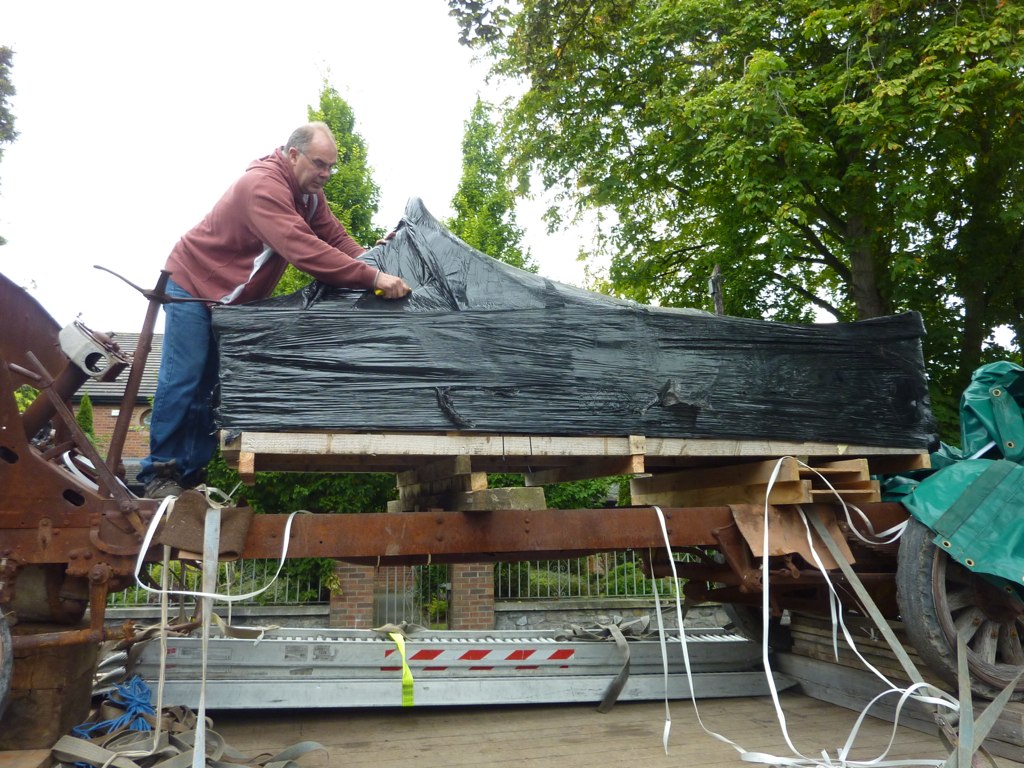 My scribbled vision:  Some mild customisations to the front, to give the car it's new name; part play on the genesis of the grille, part dig at the likely real power of the ST170 engine. I give you, the Rocket ST159. 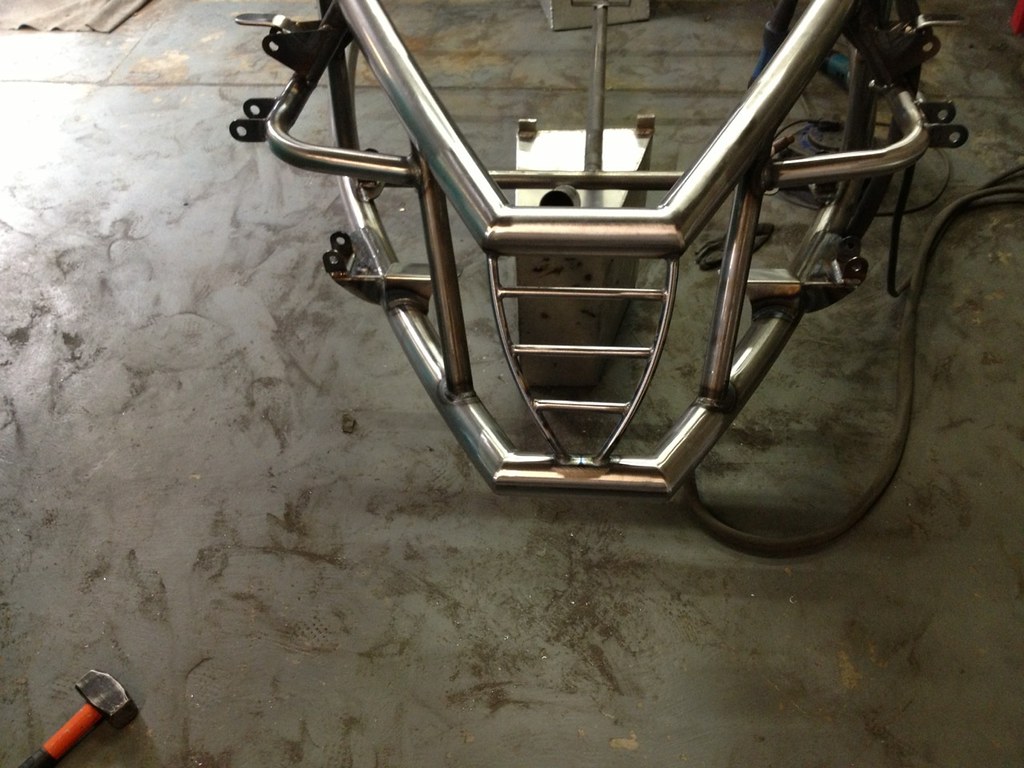 Got it up on some axle stands, have to get them covered by the time the powder goes on. I'm going to try and get any welding or brackets done before that so it's all one colour. Some bits of corrosion has formed since it was made, bit of sanding before it goes out to the Powdercoaters should sort it right out. 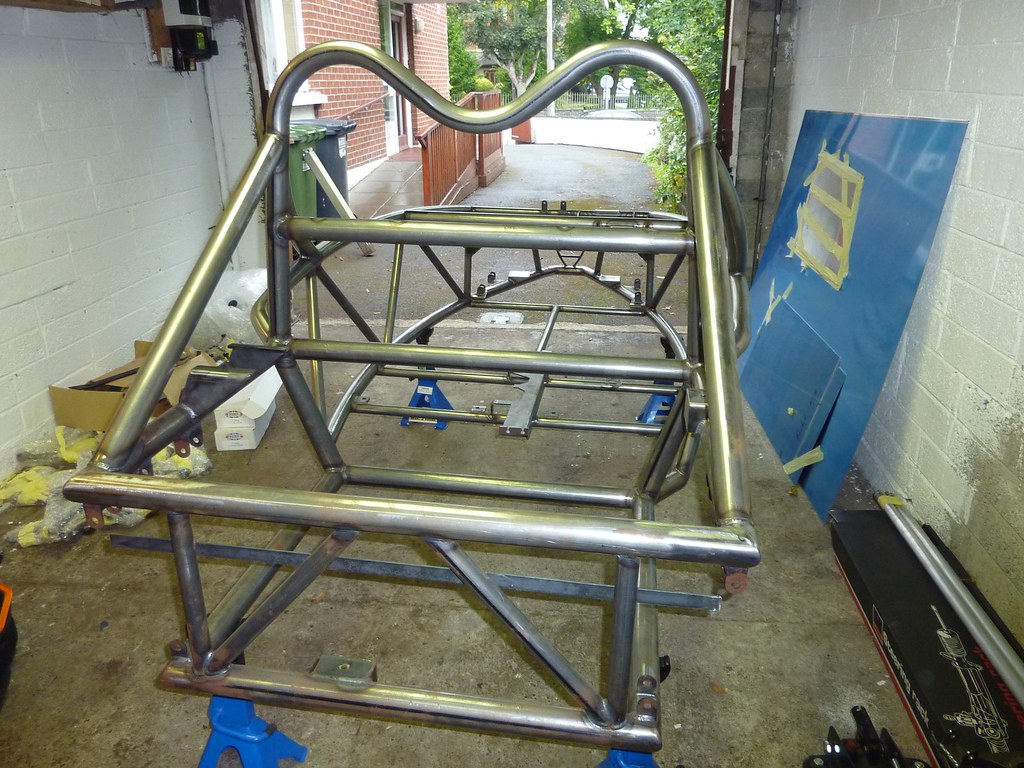
|
|
|
|
Post by Paul (madeye) on Sept 12, 2013 21:45:24 GMT
You won't need to sand mate. It will be completely blasted before it has any Powder applied.
|
|
|
|
Post by kiwicanfly on Sept 12, 2013 22:02:35 GMT
Spray it with a can of CRC400, dries to a waxy film and they reckon you can leave the coated metal outside for a year withOUT corrosion setting in.
Plus when dry the film does not get on your hands or clothes like wet spray or oil.
|
|
|
|
Post by casesensitive on Sept 16, 2013 21:03:23 GMT
UnwrappingFirst evening was spent unwrapping the parts which was like Christmas! So exciting figuring out what goodies I had. And just like Christmas and discovering there were no batteries included, I’ve prepared a snag list of what was missing and also things I’ll need to buy. A positive though, and I think this might be new for RTR; they had written on all 8 suspension pieces (bubble wrapped) where each one went (F Up, R Lower etc), which was great. I broke out my label-maker and re-labelled them as the wrapping came off, now if I can just persuade the powdercoaters to put the labels back on the pieces afterwards.. Couple of snags, including my GRP being light grey rather than the Magnum Grey I’d envisioned. Guess another few hundred to get them painted, boo. Is there any point in attempting to get them vinyl wrapped? Would the wings get wrecked? Anyone powder-coated the GRP? Too hot? 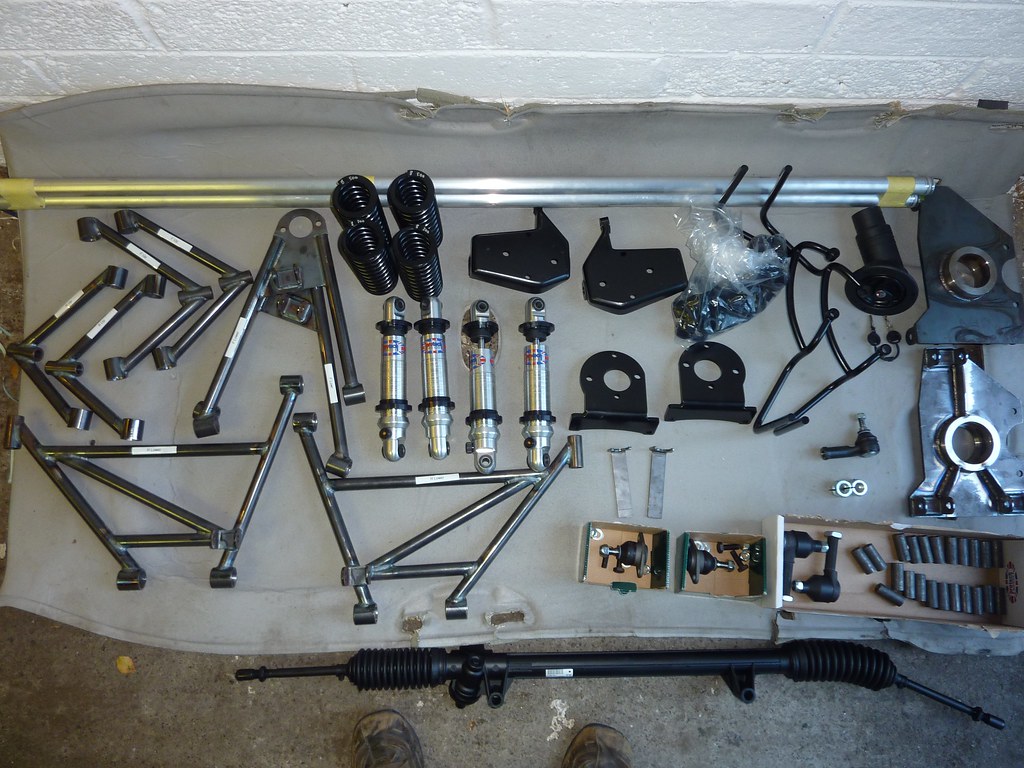 My philosophy for this build has always been to take it really slowly, and gets as good a quality finish as I can, my skills at this do not measure up to my excitement! So I’m going to do the build to about 40%, and then disassemble what I’ve got, send the chassis for powdercoating, and then do it again. So I’m going to (try to); Drill and part-fit the floor Fit and get welded the seat rails bars, fit the seats Fit the radiator (make brackets?) Build up the suspension (less the bushes and crush tubes Fit the steering rack,extension, and steering column from the donor Loosely fit the brakes, less the pipes and cable Test fit the engine mounts and drop the engine in Figure out the exhaust routing, probably have to get one custom made And then strip it back into parts again ready for powder. This allows me to make small mistakes and be rougher with the chassis than I’m prepared to be with my shiny paint on. First NightAfter unwrapping, I spent the remainder of the first night (I ended up staying past midnight, wife was away) just walking around the chassis trying to figure out where to start, what goes where and worrying would it all fit. Ultimately, I didn’t make a single measurement or cut, I just sat my seats, on rails onto what looked like it would hold them, finding the seat rails from , annoyingly, about 3cm too short to span the bars. Looks like I’ll have to get some thick bars and get them welded on. I had been dumpster diving earlier in the day, and in addition to the big cardboard boxes I went looking for, I scavenged some rubber matting with some messy cutting mistakes in it, fortuitously, almost exactly as wide and a foot longer than the chassis! This was laid down on floor of the garage and should mean I don’t scrape the chassis turning it over. Flipping the chassis over by yourself and not accidentally letting its weight support on a bracket of some sort is a bit of a job, best done very carefully and slowly. Really, I’d have paid my little brother to help if I was doing it again.
|
|
|
|
Post by kiwicanfly on Sept 16, 2013 21:46:30 GMT
Very detailed diary there, good reading.
A couple suggestions.
Can I politely suggest you break it into smaller chunks in the future, it makes it easier to comment on specific things for ideas and suggestions.
I would leave any welding till later as you may want to tweak things as you go and welding is not so easy to change.
Get the floor on with clico's or something similar. I tried using a temporary floor and it was crap, fitting the proper floor enables you to fit other things knowing they are correct because it gives the correct datum. With clico's you can have it on and off in a few minutes. Don't use rivets thinking you can drill them out, you can but you end up with dead rivets inside the tubes which is not a biggy but is annoying plus getting under the car to drill would be pain.
When fitting the suspension make up some temporary bushes, you can use the proper crush tubes, you won't be able to set up the suspension properly without this, but you don't damage the proper bushes.
When turning the chassis over put blocks of wood under the pivot points then any brackets are kept off the ground. I flicked mine over a few times on my own.
|
|
|
|
Post by kiwicanfly on Sept 16, 2013 21:49:52 GMT
Don't worry about labelling the parts you will get to know them like little children before your are done plus most parts have only one location. As long as you know which are the front and rear uppers there is no problem.
|
|
|
|
Post by casesensitive on Sept 17, 2013 18:41:25 GMT
Fitting the floorI read some interesting ideas on floor fitting on other guy’s build guides, and I was very seriously going to attempt to build a jig from MDF like Jacksdad did. In the end, I remembered that I nearly always mess these things up, so I opted for the counter-intuitive ‘measure once, cut twice’ method. The idea being I’d do a very rough cut, much bigger than I needed, all ‘round, then trim that, then file it to precisely the size I wanted by eye. TemplateAfter dragging a tape over the rocket (~3150 x 1150 in case you wanted to get one in or on a vehicle) I stitched a piece of cardboard a little larger than the Rocket’s base, made by joining pieces of two sturdy cardboard boxes from the opposite side with Duck tape. I placed this on top of the rubber matting, lowered the chassis (awkardly, I’m doing this solo) onto the cardboard and shuffled it around until it was as centred as possible. ![http://farm3.staticflickr.com/2823/9765496181_8fdbe1da1b_c.jpg]() I then drew around the outside edge of the rocket, making sure to angle my Sharpie away rather than towards the Rocket, giving me an outline at least 10mm bigger than the frame. I then cut this out using first a nice scalpel to give the line, and then deeper with a stanley/box knife. 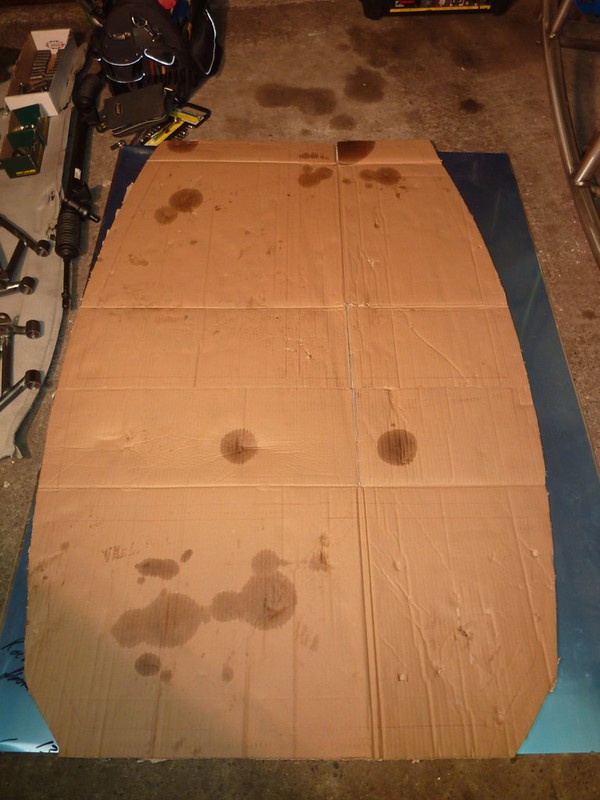 I then placed this on the upturned Rocket chassis, and placed the ally sheet on top to sanity check the fit, make sure it wasn’t buggered up somehow  I flipped over the ally sheet and template, and ran around the outside, giving a wider version of the Rocket floor. 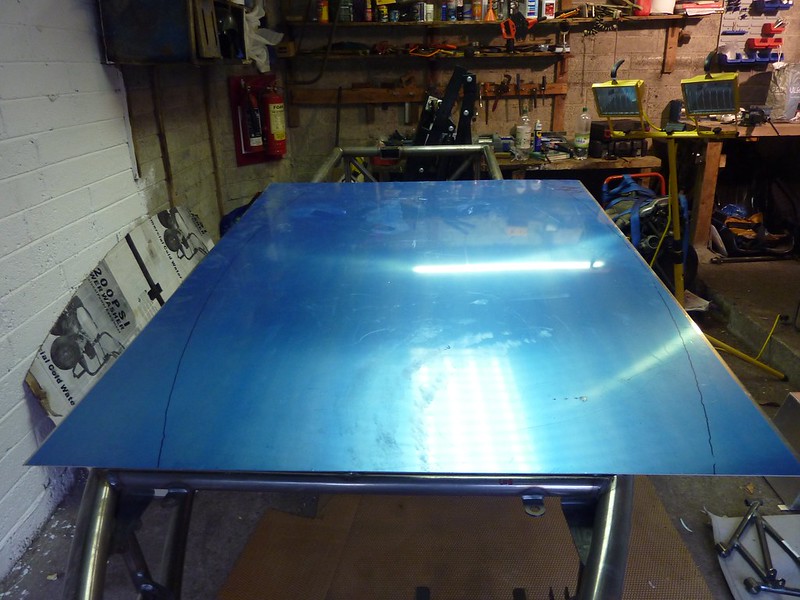
|
|
|
|
Post by casesensitive on Sept 17, 2013 18:42:50 GMT
Weapons of choiceSharpie Scalpel Stanley knife Jigsaw, size 7 metal cutting blade ear protectors, mask, goggles at least 4 c-clamps with at least 55mm opening Centre punch and big hammer Drill and 2mm and 5mm bits, cobalt if you have them Tin snips Rasp File Calipers or ruler Big rubber mallet Sand paper (80 and 180 grit) and hand sander Deburring drillbit 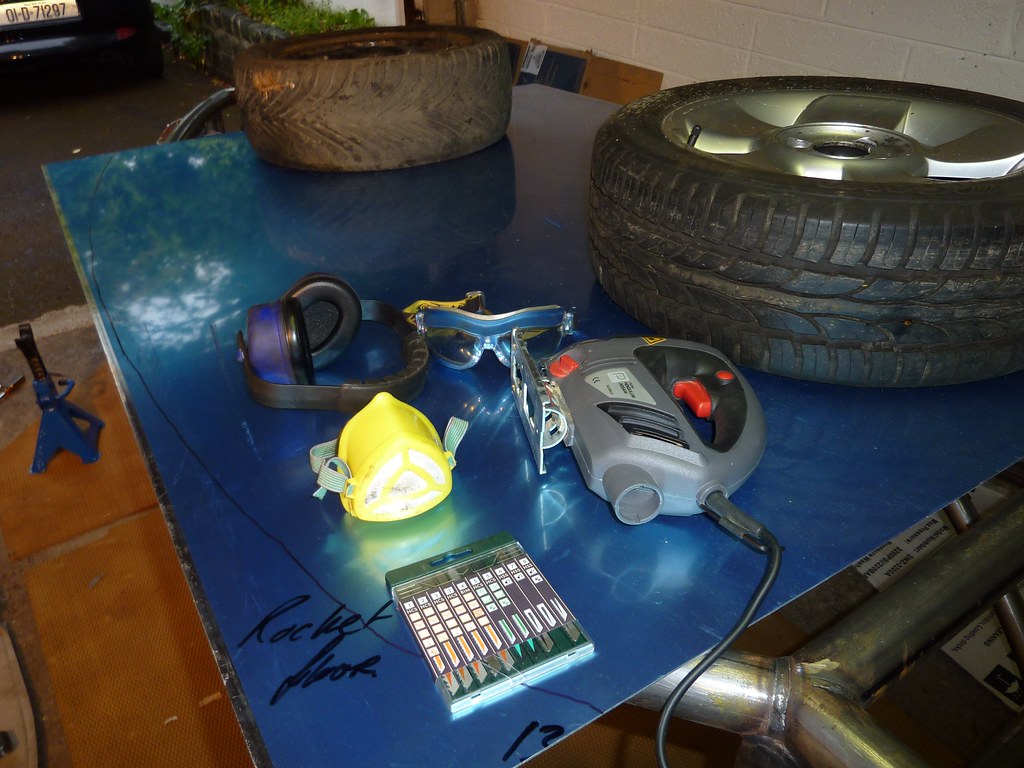 Cutting and sanding aluminium needs breathing protection, so goggles and mask are de rigeur. I ended up using other ones, the seal on that mask is crap, I just can’t bring myself to throw it out. Ear protection helps, I find I get monster headaches after a few hours. Most normal people would get through this whole thing in 90 minutes, I took almost 9 hours at it all told! Jigsaw with size 7 metal cutting blade and handy laser guide. I brought the wheels in closer for the cuts, starting with a horizontal mid point cut so that when I cut along the long side the first half would drop off as I completed the first half of the cut, rather than hanging out. I then set the ally sheet in place on the chassis, adjusting it carefully with a rubber mallet until it was perfectly straight at the two ends (which come exactly the ‘right’ length). I then clamped it in place with 4x 4” C-clamps, and added a couple of other assorted one to be certain. 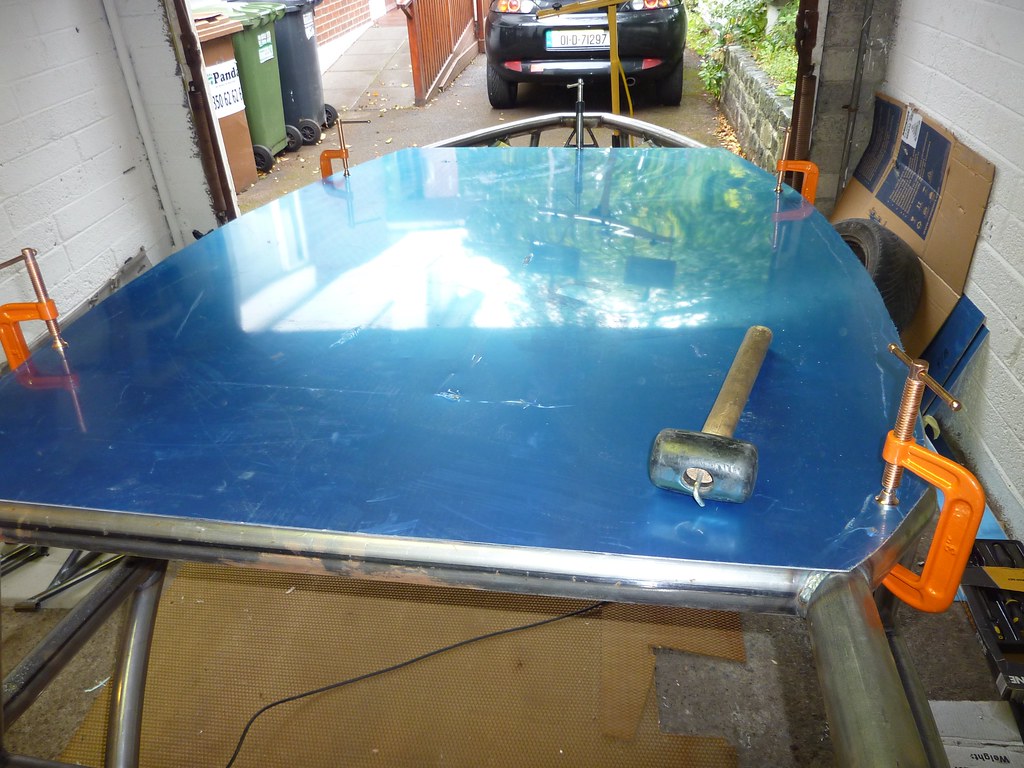 I then used a centre punch to mark the position of 4 guide holes, making sure they were over tubes and not welds 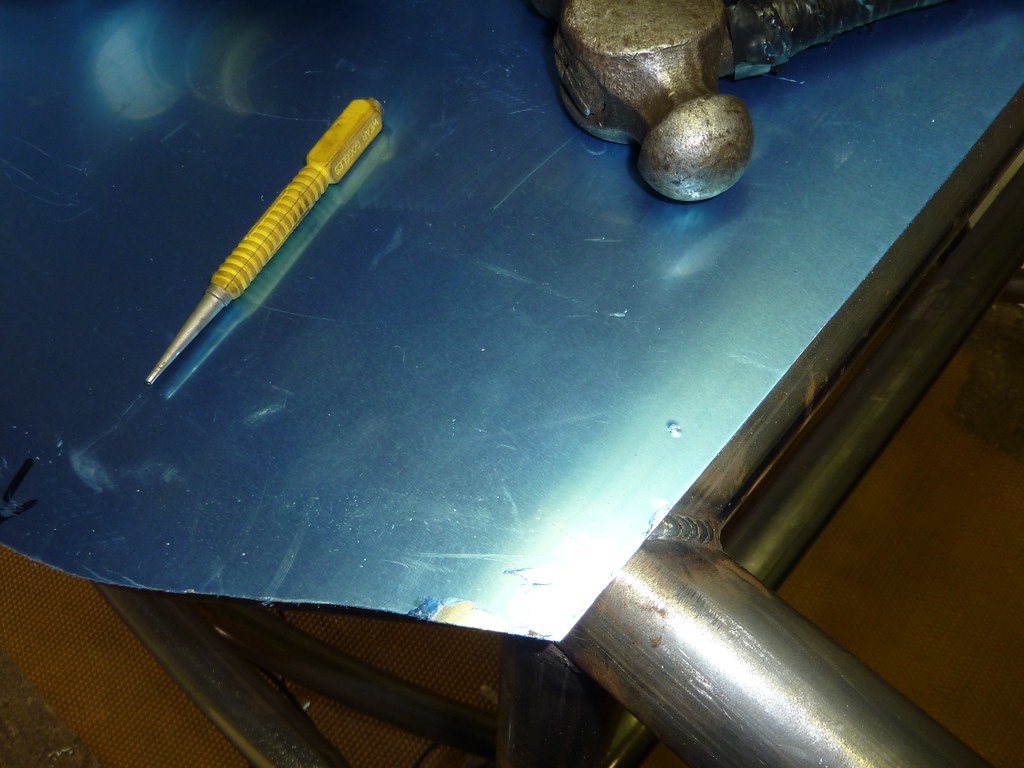 I nervously drilled a 2mm hole through the ally sheet into the chassis, and was relieved to find it went dead centre through the tube. 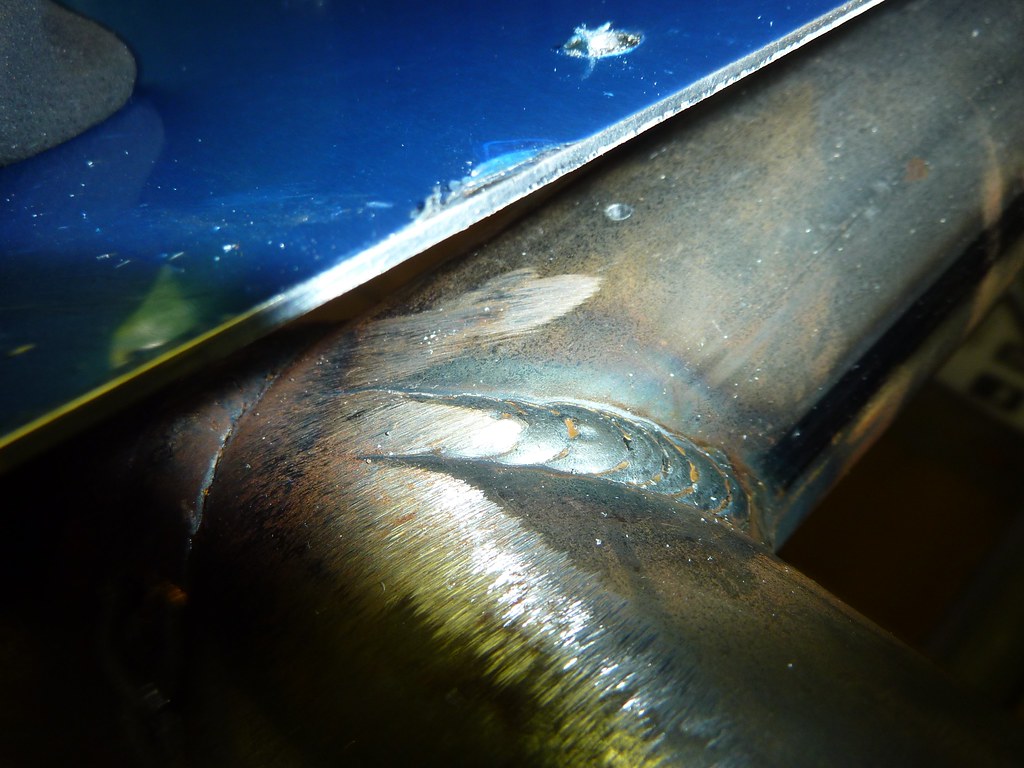 I expanded it carefully to 4.5mm with an appropriate bit, and trial-fitted my rivet, which didn’t fit, so I went through with the 5mm, and retested, like a glove. I repeated on the other 3 corners, skipping the 4.5mm hole on the rest of the holes. I then dropped a couple of long m5 machine screws into three of the holes, a drill bit in one because that’s what I had lying around! 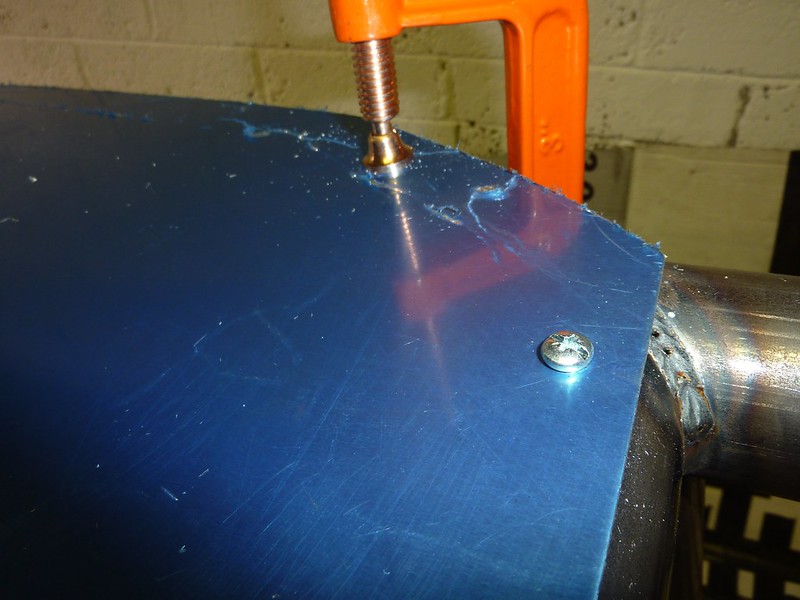 This made sure it was secure enough to be absolutely rock-solid for the next bit, which had potential to get jiggly. 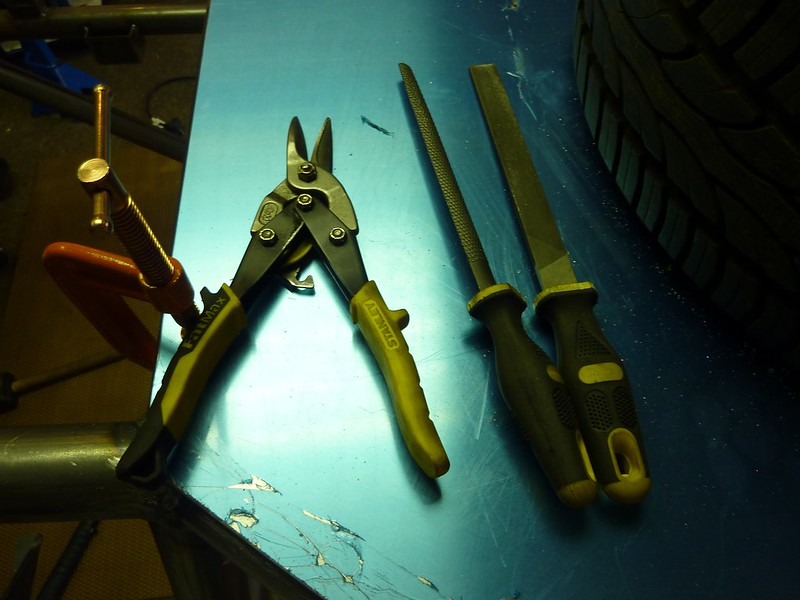 I decided on what sort of fit I wanted, decided on about 8mm shy of the edge of the frame, so I cut the overlap with the snips to about 2-4mm wider than that, leaving enough to file down with the rasp. The eagle-eyed will have spotted that I’ve used a wood rasp, but don’t knock what works, if you have to gouge lots of metal, it does the job. For purely aesthetic purposes I’ve put a chamfer/bevel on the floor section, no one will see it, no one will care, but I’ll know. 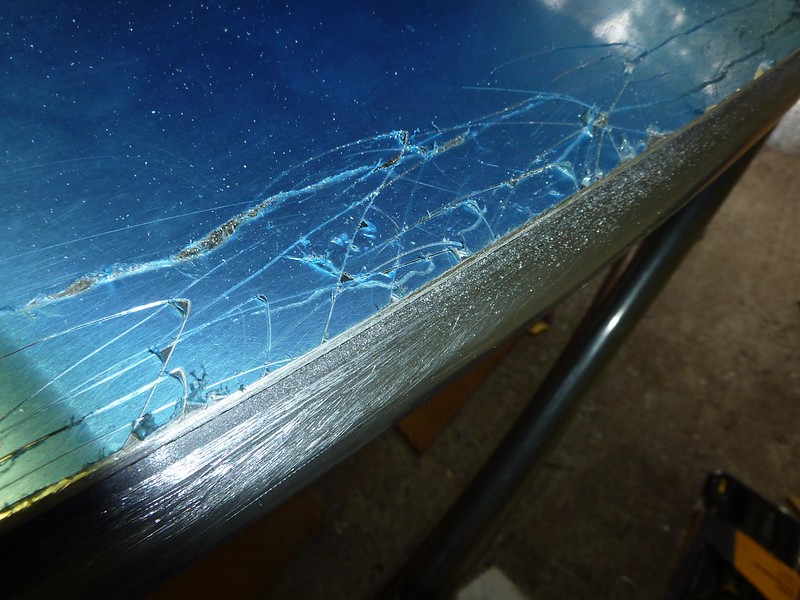 I then ran a finer file over the now-pretty-rough edge, and then 80, followed by 180 grit sandpaper for a decent shine. I've stuck together some of the video I took while doing this, before the bloody battery ran out. I hope to do lots more as I go through the project.
|
|
|
|
Post by casesensitive on Sept 17, 2013 18:43:16 GMT
Drilling the holes
Once I had a reasonable edge on the floor, I set a calipers to exactly 100mm and marked off hole positions at what I reckoned (by Mark I eyeball) would be dead centre over the tubes, giving them a good whack with a ball hammer via a centre punch. 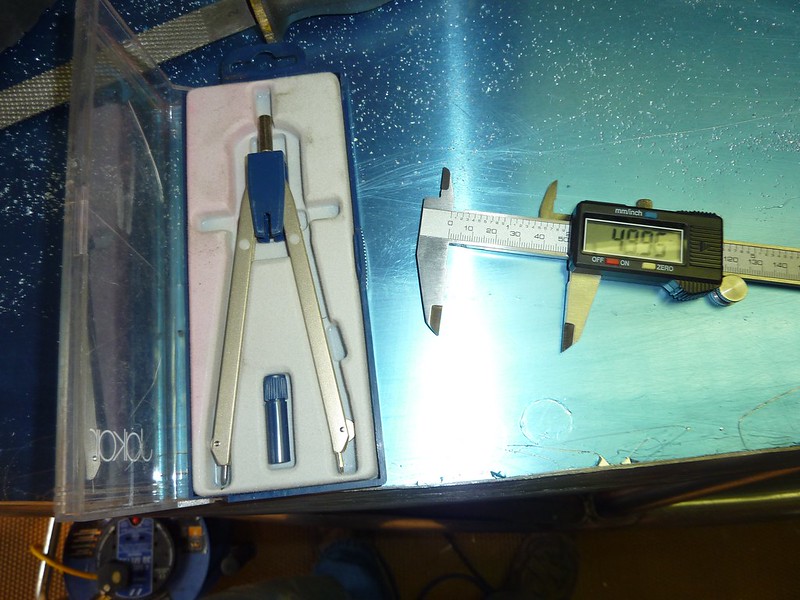 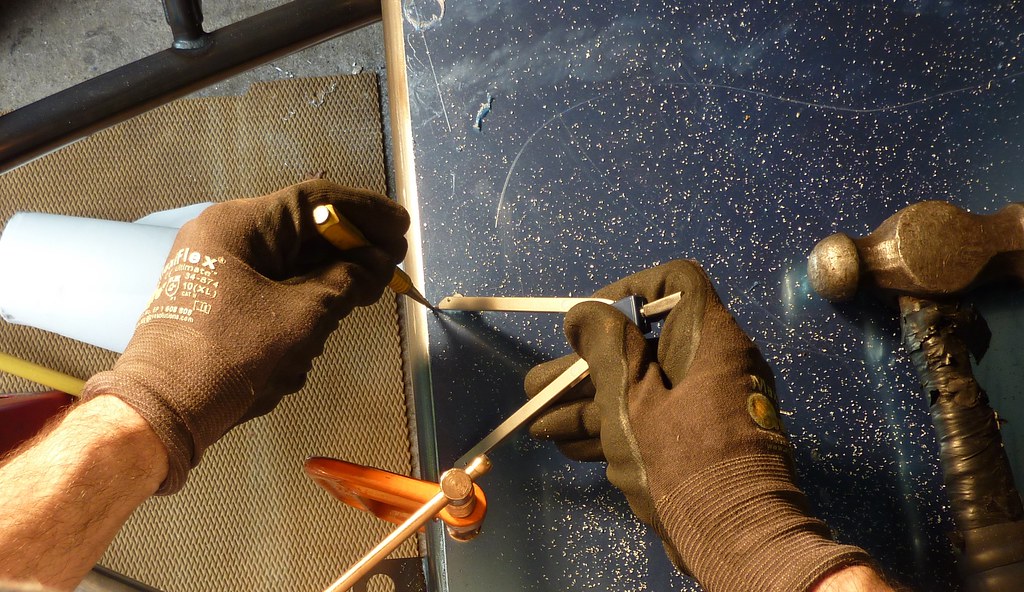 I then went through each of the punched holes with a 2mm drillbit, followed by a 5mm one. Having read both the instructions and other guides, I expected to break a few of these, but I splashed out a bit extra on the cobalt bit the man in the shop insisted I needed to go through stainless steel. The trick to not breaking them apparently is to drill slowly (<1000rpm), which I did religiously, and my chassis is not full of broken metal. 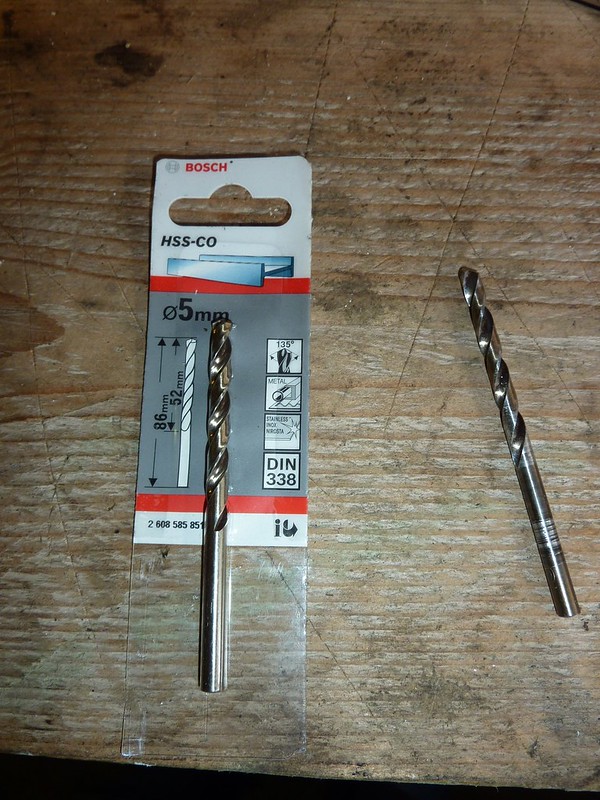 I then climbed under the chassis and marked the underside of sheet carefully with the sharpie to get the centre tube and seat support lines. I lifted the ally sheet off the chassis, placed it on the pallet the kit came on, outside which was now sunny. I used the calipers to mark the centre line of tubes, then centre punched the holes 100mm apart, then the 2mm, then the 5mm drillbits through it, carefully mind, with nothing supporting it, it’s easy to depress the sheet. With the holes now in the right places in the ally sheet, I laid it back on the chassis. I then centre punched the chassis, through the holes in the sheet. You need to give it a really solid whack, the steel takes a good bit more marking than the aluminium. Then 2mm, then 5mm bits again 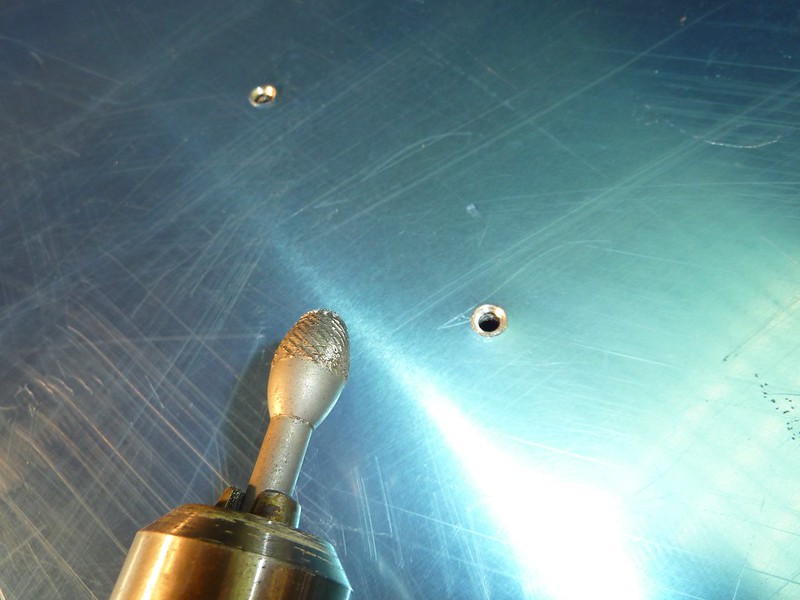 Tedious, but I went over both sides of each hole in with the ally, and all the holes in the chassis with a deburring drill bit, really short, 1 second for the chassis, half a second for the ally. Then 80 grit, then 180 grit with the mouse sander. 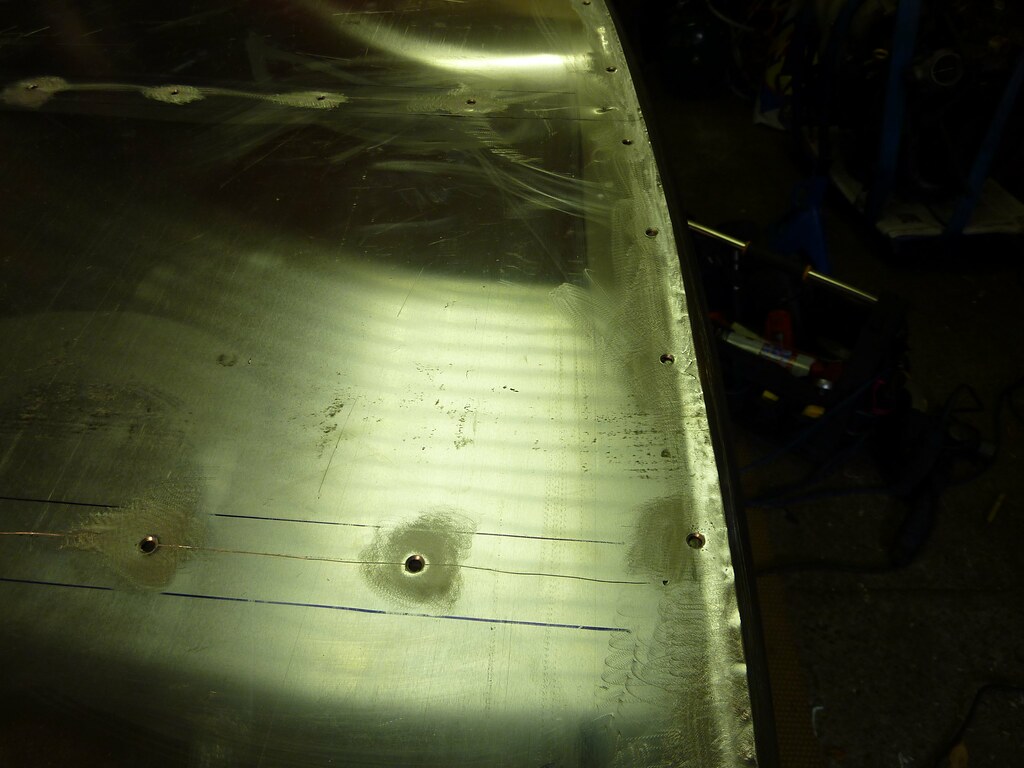 You can see from the image above where I’ve formed the floor to fit the chassis around the edges. I did one side with the round side of a ball hammer, which was overkill, the other side was done much tidier with a big rubber mallet swung with vigour. All in all, I’m extremely happy with results :-) 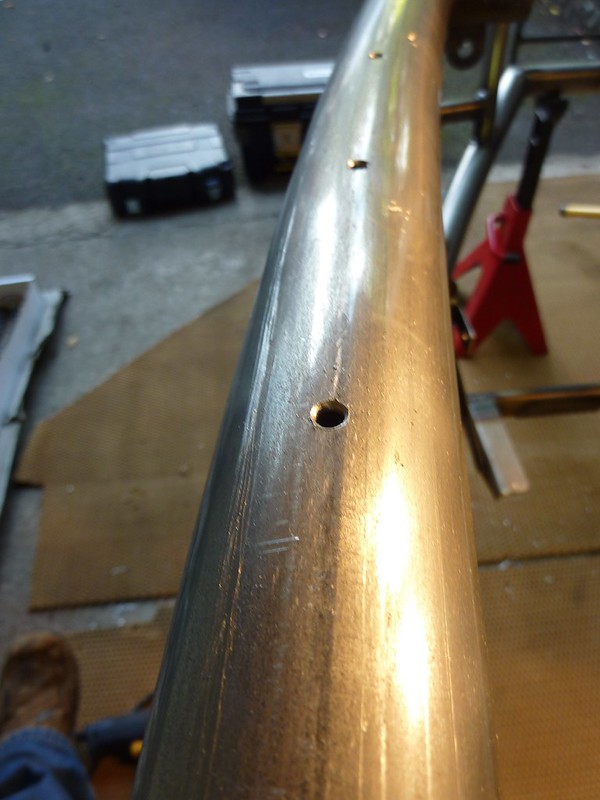 With all that done, the floor came off and was stored away for after Powdercoating when the rivets will go into it, and I’ll do the obligatory rivet forest shot! I’ll cut the front nose floor section when it arrives with the rest of my missing parts >:-|
|
|
|
|
Post by casesensitive on Sept 17, 2013 18:53:39 GMT
Can I politely suggest you break it into smaller chunks in the future, it makes it easier to comment on specific things for ideas and suggestions. Yep, good idea, I've split it up now. I would leave any welding till later as you may want to tweak things as you go and welding is not so easy to change. Will this not ruin the powder coat though? I'm torn as to how to proceed now, because I want to fit the various bits, but I want to ensure it all fits, the seats being key. But the centre tunnel is still on the floor in Nottingham somewhere, so I can't test fit the seats or fuel tank till I know how much space I'll need in the middle. I'm definitely going to have to secure the seat rails with some sort of bars, and while a bolt in a crush tube cut to fit should work, I think I'd feel better about them if they were (also?) welded on. Get the floor on with clico's or something similar. I tried using a temporary floor and it was crap, fitting the proper floor enables you to fit other things knowing they are correct because it gives the correct datum. With clico's you can have it on and off in a few minutes. Don't use rivets thinking you can drill them out, you can but you end up with dead rivets inside the tubes which is not a biggy but is annoying plus getting under the car to drill would be pain. When fitting the suspension make up some temporary bushes, you can use the proper crush tubes, you won't be able to set up the suspension properly without this, but you don't damage the proper bushes. When turning the chassis over put blocks of wood under the pivot points then any brackets are kept off the ground. I flicked mine over a few times on my own. Temporary bushes? Outta wha'? I 20%-fit two bushes (just the tip, way way) and a crush tube into one of the front upper suspension 'bones, and it went it very easily (in a vice); looks like RTE are chamferring the crush tubes out of the factory now. I didn't push them all the way in because I wasn't confident I could get the OUT again |
|
|
|
Post by kiwicanfly on Sept 18, 2013 0:26:55 GMT
I would leave any welding till later as you may want to tweak things as you go and welding is not so easy to change. Will this not ruin the powder coat though? I'm torn as to how to proceed now, because I want to fit the various bits, but I want to ensure it all fits, the seats being key. But the centre tunnel is still on the floor in Nottingham somewhere, so I can't test fit the seats or fuel tank till I know how much space I'll need in the middle. I'm definitely going to have to secure the seat rails with some sort of bars, and while a bolt in a crush tube cut to fit should work, I think I'd feel better about them if they were (also?) welded on. Definitely weld before powder coating but not at this early stage unless you are 100% sure of positions. If you want to fit your seats first, which I personally don't think is a good idea, then just drill through, no need to even fit crush tubes, then you can have a trial fit and change without having to cut off welds. Most people fit the pedals and steering before the seats and line seats up to that, even the centre tunnel has caught at least one out in relation to the seats - see Jacks build. Also you might want to weld other things as well. I stripped mine completely when I got the welder in to ensure I did not spatter other components. I put little brackets on for the copper fuel line to flexi fuel line interface (only applies if you are using copper of course!) Being able to try things on an uncoated chassis is great as you simply don't need to woory about scratching things or added/cutting off things. When fitting the suspension make up some temporary bushes, you can use the proper crush tubes, you won't be able to set up the suspension properly without this, but you don't damage the proper bushes. Temporary bushes? Outta wha'? I 20%-fit two bushes (just the tip, way way) and a crush tube into one of the front upper suspension 'bones, and it went it very easily (in a vice); looks like RTE are chamferring the crush tubes out of the factory now. I didn't push them all the way in because I wasn't confident I could get the OUT again You mentioned you were going to build up the suspension minus the bushes and crush tubes, this wont work it will all be too loose so you need something to fill the gap. I made aluminium bushes similar in size to the plastic bushes (same diameters and shoulder width but shorter on the length that goes into the suspension). I then fitted the suspension using these and the correct crush tubes. If you have access to a lathe then it is easy, any material will do I just happened to have a piece of aluminium lying around. If you don't have access to a lathe it makes it a little trickier but not hard to make something up, you could probably get away with wood if you need to. My reason was simply to avoid putting the bushes in only to have to remove them again and almost definitely do damage. Can't believe RTR can't get a tunnel to you overnight! Anything else missing? |
|
|
|
Post by Barney on Sept 18, 2013 7:11:26 GMT
One big surprise that I've found is the lack of surplus material in the floor. Width is over but front to back is very tight.
I've sat the chassis on top of the Ally sheet but found it "awkward" to judge how much the two different sized tubes need because the tubes obscure the view. Need to use "Natures Gauges" (fingers) to judge the overlap. Havn't committed to cutting yet.
|
|